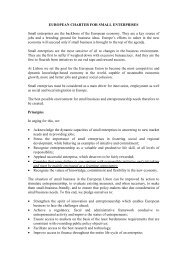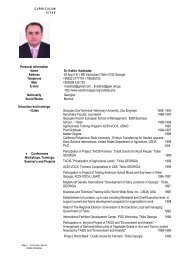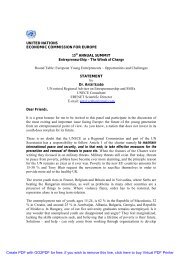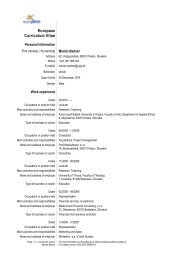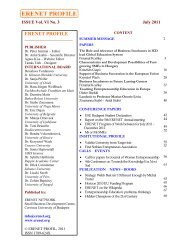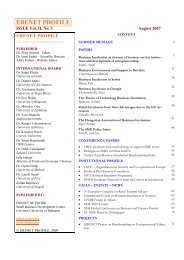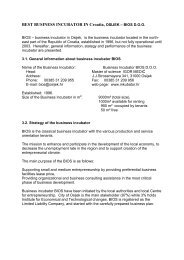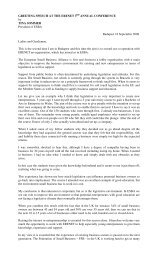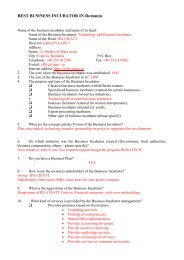Strategies of the Development of Entrepreneurship and SME
Strategies of the Development of Entrepreneurship and SME
Strategies of the Development of Entrepreneurship and SME
You also want an ePaper? Increase the reach of your titles
YUMPU automatically turns print PDFs into web optimized ePapers that Google loves.
3.1.4. FINANCING <strong>SME</strong>sPr<strong>of</strong>. Dr. Selami Xhepa <strong>and</strong> Msc. Mimoza Agolli from Institute for ContemporaryStudies/Albanian Center for International Trade (ISB/ACIT) in <strong>the</strong>ir paper “Small <strong>and</strong> MediumSized Enterprises <strong>Development</strong>”, (Tirana, 2004), access to finance for <strong>SME</strong> sector describes asfollowing.3.1.4.1. General description <strong>of</strong> <strong>the</strong> banking sectorBanking sector in Albania continues to be underdeveloped primarily due to <strong>the</strong>legacies <strong>of</strong> <strong>the</strong> pre-transition heritage. With <strong>the</strong> starting <strong>of</strong> transition, it was in mid-1992,for <strong>the</strong> first time a two tier banking system had to be established <strong>and</strong> a totally newbanking industry had to be developed based on market principles. The reform package on<strong>the</strong> banking sector included measures <strong>of</strong> reforming state owned banking system, througha process <strong>of</strong> mergers <strong>and</strong> splits <strong>and</strong> <strong>the</strong> encouragement <strong>of</strong> <strong>the</strong> entry <strong>of</strong> new private banks.With <strong>the</strong> privatization <strong>of</strong> Savings Bank in January 2004 by an Austrian bank, <strong>the</strong>Government <strong>of</strong> Albanian totally withdraws from <strong>the</strong> banking business. Actually <strong>the</strong>banking sector is composed <strong>of</strong> two joint venture banks, 12 privately owned by foreigninvestors <strong>and</strong> 2 owned by local investors.However, due to <strong>the</strong> dominant position <strong>of</strong> <strong>the</strong> Savings Bank, with 60 per cent <strong>of</strong>total deposits <strong>and</strong> 80 per cent <strong>of</strong> T-bill holdings, competition on <strong>the</strong> banking sectorremains ra<strong>the</strong>r limited.Banking legislation was visited frequently during <strong>the</strong> ‘90s, mostly due to <strong>the</strong> effects<strong>of</strong> <strong>the</strong> 1997 crisis <strong>and</strong> <strong>the</strong> need to streng<strong>the</strong>n <strong>the</strong> environment on which <strong>the</strong>y function. Inaddition to establishment <strong>and</strong> function <strong>of</strong> <strong>the</strong> industry, o<strong>the</strong>r important legal reformincluded <strong>the</strong> streng<strong>the</strong>ning <strong>of</strong> <strong>the</strong> financial infrastructure. Special attention was paid tolegislation on secured transaction (enacted in 2001); streng<strong>the</strong>ning <strong>of</strong> <strong>the</strong> bankruptcylegislation with a new law enacted in 2001. <strong>and</strong> reviewed (2003.) to comply with <strong>the</strong> EUdirectives; development <strong>of</strong> <strong>the</strong> deposit insurance schemes (2002.) where <strong>the</strong> deposits <strong>of</strong>up to 5,000 USD are ensured by <strong>the</strong> established agency <strong>and</strong> development <strong>of</strong> legislation onmoney laundering, etc. Increasing <strong>the</strong> banking system transparency has been <strong>the</strong> focus <strong>of</strong><strong>the</strong> reporting requirement procedures developed by <strong>the</strong> supervisory authority. On thatrespect, <strong>the</strong> Bank <strong>of</strong> Albania adopted a new accounting system consistent with <strong>the</strong>International Accounting St<strong>and</strong>ards. Ano<strong>the</strong>r important area <strong>of</strong> development is that <strong>of</strong>payment system, with a new RTGS (real time gross settlement) in operation by early..In terms <strong>of</strong> <strong>the</strong> funds intermediated through <strong>the</strong> system to <strong>the</strong> private sector, <strong>the</strong>role <strong>of</strong> banking continues to be very modest, albeit <strong>the</strong> very impressive dynamicsregistered during <strong>the</strong> last two years.The total loans to GDP continue to be at very low levels, reaching <strong>the</strong> highest 7.4%<strong>of</strong> GDP by end 2003 or a more 14.9% <strong>of</strong> total deposits on <strong>the</strong> system. While <strong>the</strong> deposits<strong>of</strong> <strong>the</strong> residents placed in <strong>the</strong> banking system rose from 29% <strong>of</strong> GDP in 1995 to 44% <strong>of</strong>GDP by November <strong>of</strong> 2003 <strong>the</strong>y share extended to private sector loans varied between 8-14% during this period.Several surveys <strong>of</strong> resource financing firms’ economic activities confirm that <strong>the</strong>banking system has played a highly limited role. The data obtained from interviews <strong>of</strong>firms (EBRD, 1999 & 2000) show that more than 20% <strong>of</strong> <strong>the</strong> large enterprises interviewedin Albania refer to state funds as <strong>the</strong>ir principal resource <strong>of</strong> financing. 5% <strong>of</strong> largeenterprises <strong>and</strong> 2% <strong>of</strong> <strong>the</strong> <strong>SME</strong>s interviewed confirm that <strong>the</strong>y have got hold <strong>of</strong> financingresources only through <strong>the</strong> banking system. 2% <strong>of</strong> <strong>the</strong> <strong>SME</strong>s list local banks as providing22



